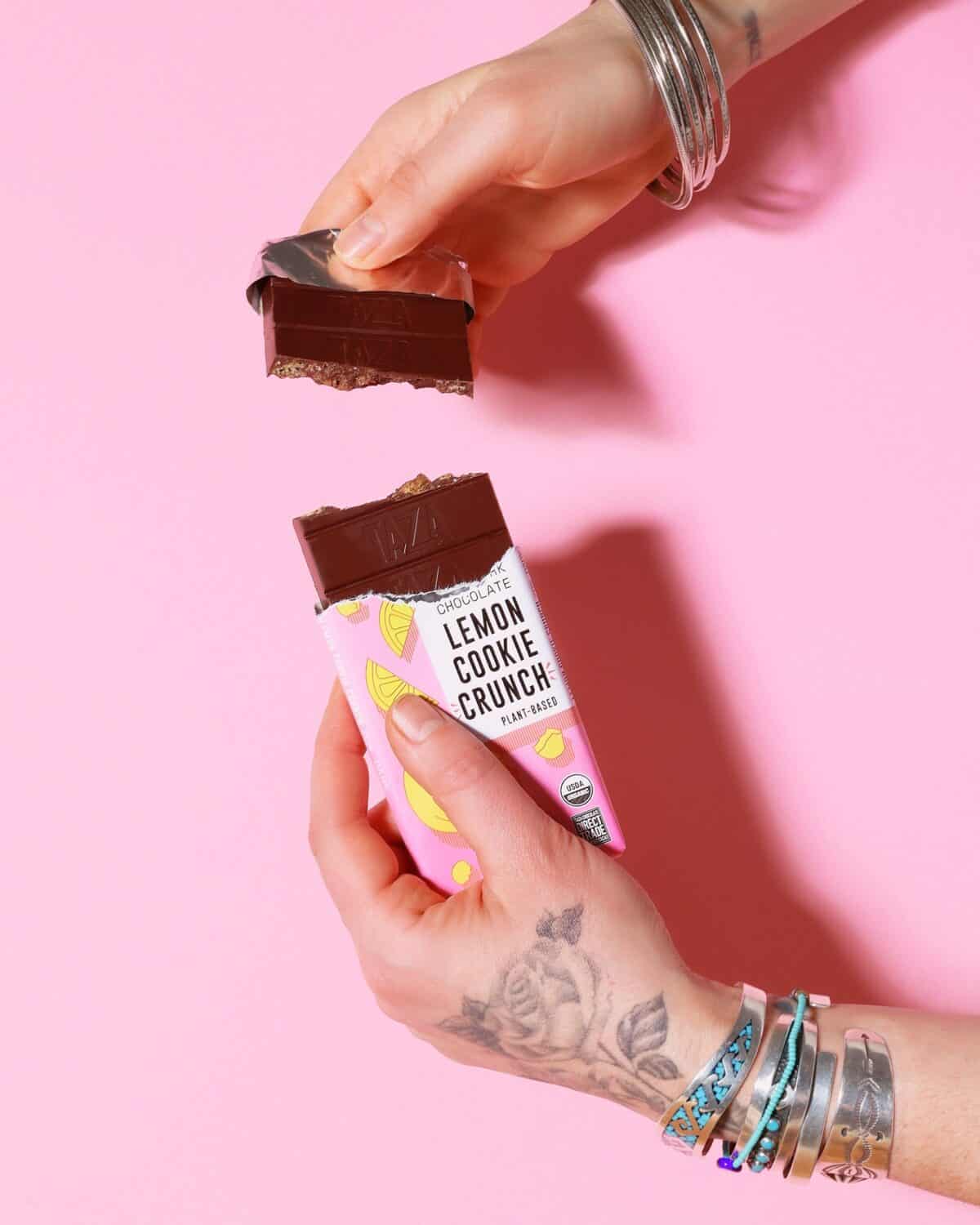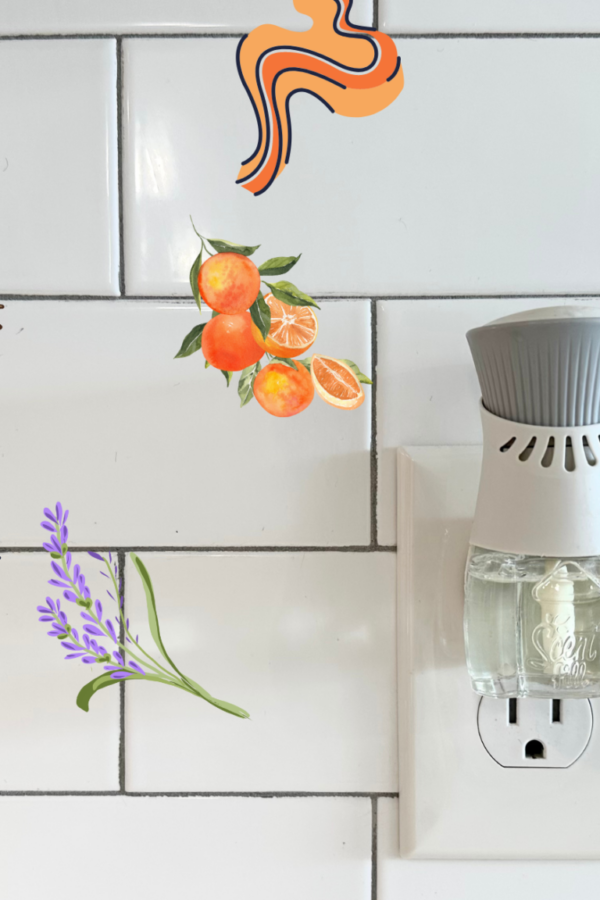In a Nutshell:
- Since it’s grown and harvested without toxic pesticides, organic chocolate is better for the consumer, the farm workers, and the environment.
- But it’s not just pesticides you have to worry about… Testing has shown high amounts of lead and cadmium in chocolate, too.
- Even though heavy metals occur naturally in the soil (where the cacao plants pick them up), there are things suppliers can do to decrease the heavy metal content in chocolate.
- Unfortunately, there is no 100% perfect chocolate. But all things considered, the brands I’d choose (for now anyway!) are:
- I’ve got more tips below on how to decrease your exposure to heavy metals through mindful chocolate consumption. 🍫
Table of Contents
This post contains affiliate links, which means we may earn a small commission if you choose to make a purchase. Featured image credit: Taza
Does It Matter If Chocolate Is Organic?
As discussed in our article on online organic food stores, organic does in fact mean better in some ways.
Although research says that there’s little to no difference in the vitamin and mineral content in conventional versus organic produce, there are more antioxidants in organically-grown crops.
Perhaps more noteworthy, though, is the topic of pesticides. Non-organic food is sprayed with chemical pesticides that have been shown to cause all kinds of health concerns, from cancer and fertility problems, to ADHD and Parkinson’s.
Some research actually draws a direct relationship between a diet that’s high in pesticides and specific health effects, such as low sperm count.
Organic chocolate was grown without the use of toxic pesticides. If and when herbicides, pesticides, and/or fertilizers are needed, only safer and more natural methods are used.
Of course, organically grown food is not only better for individual human health, but it’s better for our overall environment and the farming communities involved as well. After all, the people who are most at-risk for negative health outcomes related to pesticides are the farm workers themselves, followed by the directly surrounding communities.
Non-organic growing practices also strips topsoil of nutrients and kills the biodiversity necessary to keep our ecosystems running properly.
Lastly, this is just my opinion, but I think most organic chocolate is just higher quality and tastes better compared to the more conventional brands! Even with my sweet tooth, just a few squares from one of an organic dark chocolate brand satisfies me, and I end up eating a lot less chocolate than I would have if I were munching on a Hershey’s bar!
Heavy Metals in Chocolate
Now on to the second issue with chocolate: heavy metals.
The topic of heavy metals in chocolate make the headlines every couple of years when Consumer Reports (CR) releases their report after testing a variety of chocolate products from different brands.
Their 2022 and 2023 reports show high levels of lead and cadmium in many of the products. (None of the products they tested showed risk for mercury or arsenic exposure.)
As You Sow, a non-profit organization, has also tested many different chocolate brands and found lead and cadmium in a lot of them. (They subsequently took legal action and made some of the biggest companies fund an investigation on where the heavy metals were coming from and how to fix it.)
Both of these organizations used California’s maximum allowable dose level (MADL) to determine the “too high” cut-off. (If a product contains a toxicant above a set MADL, it’s supposed to come with the California Prop 65 warning label.)
These test results are concerning because, as most of us know, lead, cadmium, and other heavy metals come with a host of potential heath effects, from developmental delays to cancer.
So, it makes sense that a lot of consumers are looking for the safest chocolate brands!
Sorry, But Chocolate Without Heavy Metals Does Not Exist
Unfortunately, cadmium-free, lead-free chocolate does not exist. CR found these metals in at least small amounts in all of the chocolate they tested.
This in part makes sense since small amounts of heavy metals exist naturally in soil, and they get drawn up into the cacao plant as it grows. This is why there’s not really such a thing as 100% “lead-free” chocolate.
However, they also get into the soil (and water) through industrial activities (like mining, smelting, and manufacturing), agricultural practices (like the use of certain fertilizers and pesticides as well as irrigation with contaminated water), and atmospheric deposition (again, from industrial emissions).
Therefore, the levels that exist in our environment now are generally much higher than what occurs naturally. This is one of the reasons why we now have a problem with high levels of heavy metals not just in chocolate, but also in other types of crops, like sweet potatoes and carrots.
That said, as Consumer Reports points out, there are other ways that lead gets into chocolate as well. The 2022 investigation I mentioned from the As You Sow settlement found that the levels of lead in cacao were actually quite low right after harvesting. But then they went back up as they dried in the sun for days, collecting contaminated dust and dirt.
In a way, this is good news because it means there’s actually something cacao manufactures can do about the amount of lead that ends up in chocolate! They could potentially reduce the lead content significantly just by changing when and where the cacao is dried and/or cleaned.
There are other things that manufacturers can do too, like favor beans grown in areas with low-cadmium soil and mix beans from different origins so that the final product has lower levels.
Why Does Dark Chocolate Have More Heavy Metals?
As Consumer Reports points out, dark chocolate tends to be higher in heavy metals than milk chocolate. That’s simply because dark chocolate has higher cacao content, and the cacao is where the heavy metals come from.
How to Practice Safer Chocolate Consumption
Okay, so all of that is not great news… But you don’t have to give up chocolate completely! Here are some things you can do to decrease your exposure to heavy metals from chocolate:
1. Don’t overdo it.
Give chocolate it’s well-deserved treat status. Eat it in moderation.
2. Consider alternating with milk chocolate.
Most of us have been told that dark chocolate is healthier because it has higher antioxidant levels and lower sugar. And while that’s true, dark chocolate is also more likely to have more heavy metals in it. So, you may want to consider switching it up and eating a mix of dark and milk chocolate. (Unless, of course, you’re lactose intolerant!)
3. Know if you’re vulnerable.
It’s recommended that you may want to keep dark chocolate away from children, pregnant people, and those with a history of heavy metal poisoning, as these folks are at the highest risk for negative health effects of heavy metal exposure.
4. Eat a well-rounded diet.
There is no perfect food. Every category of food on the shelf has some sort of contamination issue—whether it’s PFAS, pesticides, POPs, or microplastics.
So one of the things I recommend in general (not just when it comes to chocolate) is diversifying your food intake. This can help lower the risk of exposure to contaminants from one single source.
It can also help ensure you’re getting the vitamins, minerals, and antioxidants your body needs to detoxify and stay resilient against the toxicants you can’t control.
5. Shop from safer brands.
I’ve listed the “safer” chocolate brands that I would buy below, and explained my reasoning.
6. Put pressure on your favorite brands.
As I mentioned, there are things that cacao farmers and manufacturers can do to minimize lead levels in chocolate in a relatively short amount of time.
And honestly, consumer pressure is probably going to be the fastest way to get them to act. So, you may want to consider contacting your favorite chocolate brands and put some pressure on them to update their their harvesting and manufacturing processes, and regularly test their chocolate.
The Ethical Issue of the Chocolate Industry
Okay, there’s one more issue to consider when it comes to chocolate, and it’s the fact that it has a long and dark history involving forced labor, indentured servitude, and child labor. (Sorry this sweet topic is actually such a downer!)
In 2021, for example, several of the largest chocolate companies—including Hershey’s, Nestle, and Mars—faced a class action lawsuit where they were accused of a”aiding and abetting the illegal enslavement of “thousands” of children on cocoa farms in their supply chains.” This specific case was eventually thrown out by the U.S. Supreme Court, but that doesn’t really mean much because the problem is far from solved.
Since human and environmental health are so interconnected, you’ll usually find that the brands that care about growing organically are the same brands that prioritize fair trade practices along with other ethical and sustainable practices.
It can be helpful to look for certifications that indicate eco and ethical responsibility on the chocolate you buy.
Although third-party certifications aren’t perfect, nor are they essential for a brand or product to be “organic” or “fair trade” (these certifications can be expensive for small brands), they can definitely help.
Labels like USDA Organic, Fair Trade USA, Fairtrade International, and Fair for Life provide some accountability for brands and communicate to customers that the product has been verified to meet a specific set of environmental and/or social criteria.
My Picks for the Safest Organic Chocolate
I investigated a lot of chocolate brands to see what kind of heavy metal testing I could find. The results I found primarily came from three places:
- The Consumer Reports testing mentioned above.
- The As You Sow database.
- The brand’s independent testing.
No chocolate is 100% perfect, but here are the brands I would choose, all things considered.
(And obviously brands are making changes all the time and new testing comes out every couple of years… So we will try to keep this as updated as possible!)
Raaka (Best for Organic Chocolate Gifting)

Highlights: USDA Organic, Non-GMO, Kosher, Vegan; Free of: Gluten, Nut (except coconut), Dairy, and Soy
Price: $30-$60
These beautifully-wrapped luxury chocolate bars are made in Brooklyn, New York out of sustainably sourced, unroasted cocoa beans. They come in several unique and tasty flavors, including Bourbon Cask Aged, Bananas Foster, Green Tea Crunch, Cabernet Sauvignon, Pink Sea Salt, and more.
And if you’re wondering why this organic chocolate gift box has the word “Library” in it, it’s because it comes with a 16-page(!) booklet which takes you through the entire process Raaka chocolate goes through, from sourcing to the end creation. It makes for a truly unique and immersive experience for your recipient!
They also offer a chocolate subscription, which you can get in a 3-month, 6-month, or 1-year increment.
In terms of heavy metals, Raaka does their own testing with a third-party lab. (They have not been tested by CR or As You Sow). Raaka states that they are committed to keeping their chocolate below California’s Prop 65 rules (which are pretty much the strictest in the US for heavy metals) and that they “work with their partners at origin” to make sure they’re always improving things.
But the thing that really sets them apart from the rest of the brands is that they actually publish their test results right on their website for you to check out for yourself.
(And if you want some flowers to gift alongside the chocolate, here are some resources for you!)
Taza


Highlights: USDA Organic, Direct Trade, Non-GMO, Vegan, Kosher, Gluten-Free, Soy-Free, low in heavy metals
Carries: Bars, discs, crunchy bars, bark, chocolate covered nuts, baking chocolate, gift sets
Taza has a lot of options, so no matter what your chocolate preferences are, you’re sure to find something you love.
For their signature Mexican-style chocolate, they use traditional Mexican stone mills (called molinos), to make unrefined, stone ground chocolate from bean to bar, right in their own chocolate factory in Somerville, Massachusetts. This unrefined and stone ground process makes for a little bit of a different taste and texture than what you might be used to. It’s got a little more grit to it, but a very full and luxurious flavor.
But if the stone-ground chocolate is not your thing, don’t worry: they’ve also got a tasty collection of Smooth & Crunchy bars, which have the texture most Americans are used to.
The team at Taza is committed to fostering direct trade relationships with their chocolate farmers and they publish a transparency report each year so customers can find out more about their entire supply chain.
They’ve got lots of options for organic chocolate gifts, too—like their chocolate disc sampler or their virtual tasting kit!
They also have other kinds of snacks like chocolate covered nuts, barks, and espresso beans.
In terms of heavy metals, they came out as a winner in the Consumer Reports testing, with both the lead and cadmium levels below the MADL. However, the As You Sow database shows several tests above the MADL. That was mostly for cadmium; they only had one lead result above the MADL and that was back in 2015.
The reason I’m keeping them as a recommended brand despite the high cadmium in the As You Sow testing is that they seem to be taking active measures to make improvements. For example, they’ve stated that they intentionally mix chocolate from different origins in order to decrease the metal content in the final product—a relatively easy solution I mentioned earlier.
Mast


Highlights: USDA Organic
Carries: Bars, baking chocolate
Mast is handcrafted in-house, in small batches, with minimal ingredients. For their chocolate, they source exclusively from certified organic cacao from Kokoa Kamili in Tanzania. Although it’s not Fair Trade certified, they say they “pay far beyond fair trade premiums and several times commodity prices.”
I could only find one test for Mast (from Consumer Reports), but on that test, they were below the MADL for both lead and cadmium.
Justin’s


Highlights: USDA Organic, Rainforest Alliance Certified, Non-GMO Certified, Certified Gluten-Free, Orangutan-Friendly Palm Oil
Carries: Nut butter cups, chocolate candy pieces
You probably know about Justin’s organic chocolate nut butter cups. They’re usually easy to find in stores like Target and Walmart.
In terms of heavy metals, I could only find one test for Justin’s (in the As You Sow database), but what’s noteworthy is that the lead levels were “non-detect,” which means they were either non-existent or so low that the lab test couldn’t pick them up. This is rare for chocolate!
Unfortunately, the cadmium level in that test did exceed CA’s MADL, but it wasn’t that much over.
My theory for this is that since Justin’s cups don’t have as much chocolate in them as a regular chocolate bar, there’s not as much exposure to the heavy metals. This could be helpful to keep in mind… Perhaps you can get your chocolate fix from a nut butter cup instead of a bar so there’s less overall cacao.
Even More Organic Chocolate Brands
The following organic chocolate brands have a lot going for them. Many of them come with several third-party certifications for ethics and sustainability. Several of them are made by artisans and small businesses.
But, many of them either tested high in the Consumer Reports investigation, or I couldn’t find any testing for heavy metals at all.
* Brands with an asterisk are ones in which either Consumer Reports and/or As You Sow found high levels of lead, cadmium, or both.
^Brands with a caret means I wasn’t able to find any heavy metal testing.
- *Alter Eco
- Bars, truffles
- USDA Organic, Gluten-Free Certified, Fair for Life, B Corp
- *Beyond Good
- Bars, melts
- USDA Organic, Certified Direct Trade, Kosher, Non-GMO, Vegan options, Gluten Free, Soy Free
- They say they test for heavy metals once a year, but they don’t provide any results or details. In CR’s testing, their lead was below CA’s MADL, but the cadmium was not.
- ^Dr. Bronner’s
- Bars
- USDA Organic, Fair for Life, Vegan options, Non-GMO, B Corp
- *Equal Exchange
- Bars, chips, minis
- USDA Organic, Vegan options, Kosher, Fair Trade Federation member
- *Evolved
- Bars, cups, gift sets.
- USDA Organic, Rainforest Alliance Certified, Beyond Celiac Gluten-Free; Free from: Peanut, Dairy, Soy, Refined Sugar
- They say they do their own testing, but they don’t provide results or details.
- ^Farmhouse Chocolates: Truffles & caramels. (Certified Organic, Fair Trade, Non-GMO, Small Batch; Free of: Soy, Corn Syrup)
- *Hu
- Bars & baking chocolate
- USDA Organic, Non-GMO, Paleo, Gluten Free, Vegan options, Kosher; Free from: Cane Sugar, Emulsifiers, Sugar Alcohols
- ^Living Ratio
- Chocolate truffles.
- Certified Organic, Vegan, Keto Friendly / Low Sugar, Fair Trade practices; Free of: Gluten, Soy, Palm Oil
- When we emailed them, they said “We consistently test our cacao for Lead, Cadmium, Arsenic, and Mercury, as do our suppliers, and fall well below the chocolate thresholds set by California guidelines.” However, they did not provide any results or other details.
- *Pascha
- Bars, baking chips & chunks
- USDA Organic, Rainforest Alliance Certified, Certified Vegan options, Certified Gluten-Free, Kosher
- *Theo
- Bars, cups, candies, baking chocolate, gift sets
- USDA Organic, Fair for Life, Kosher, Vegan (dark), Free of: Soy, Gluten
- They say they’re taking active steps to reduce heavy metals.
- ^Thrive Market
- Bars, truffles
- USDA Organic, Fairtrade Certified, B Corp, Vegan options, Dairy Free
- ^Unreal
- Peanut butter cups, gems (like M&Ms), nougats.
- Non-GMO, Fair Trade, Vegan, Gluten Free, Some organic ingredients, RSPO certified palm oil. Some of their ingredients are organic, but not all.
- They say they don’t test their finished products for heavy metals, but they source from suppliers who do.
I know this is kind of a confusing and overwhelming topic, but I hope this guide has helped you find some of the safest organic chocolate that’s low in lead and cadmium so that you can snack with some peace of mind!




